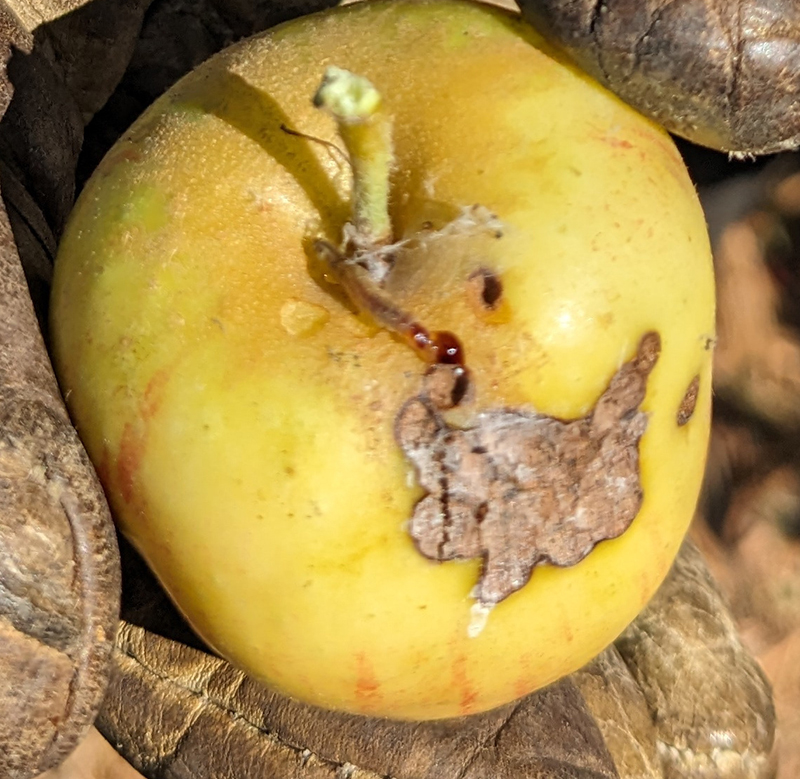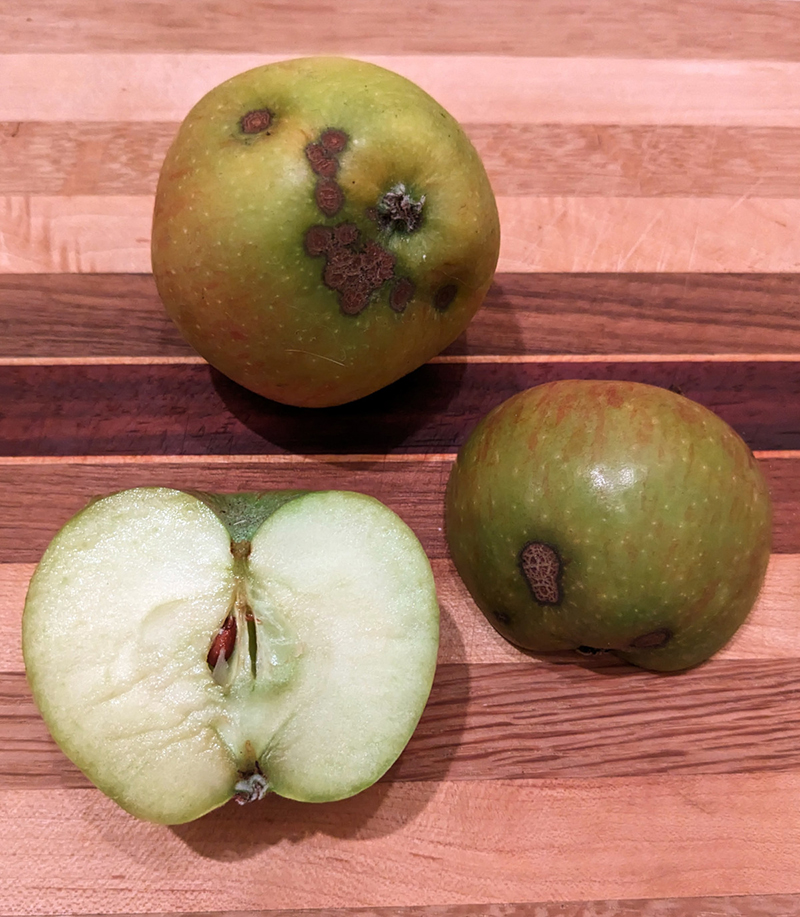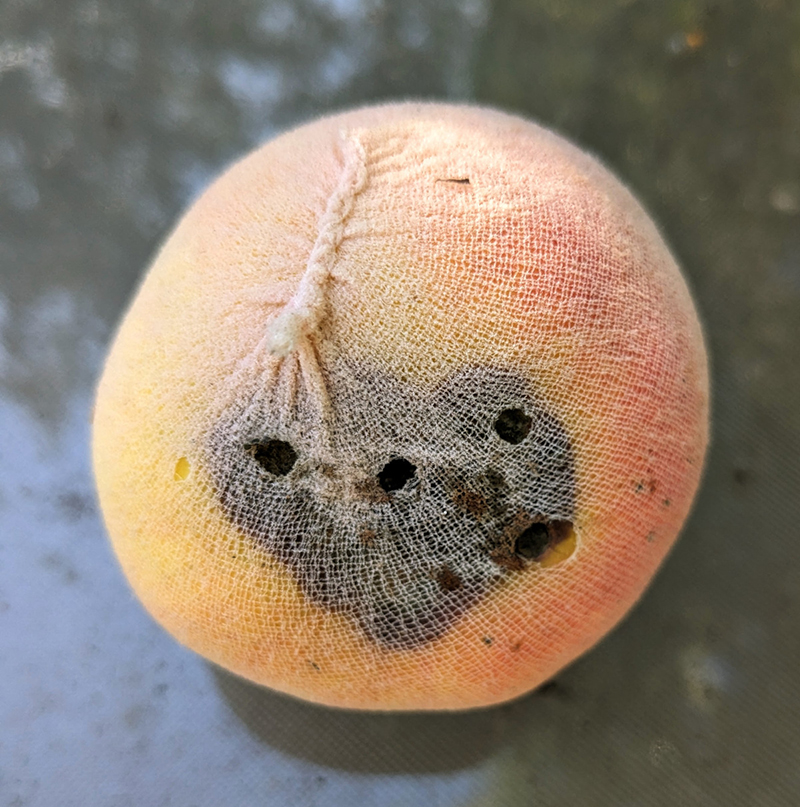Can You Identify These Apple Pests, Diseases or Conditions?
by Marla Koss, October 26, 2023
Let’s take a quiz! (Answers are listed at the bottom of this quiz.)

1.
A tell-tale sign of this serious disease afflicting many rose family trees and plants – including pome fruits – is the “shepherd’s crook.” The Callery Pear street tree we see around Alameda is a dandy vector for this pathogen; bees buzz around its lovely white blossoms and carry bacteria to blossoming apples and pears.
This bacterium can wipe out whole orchards in a single growing season. The California Gold Country area up along I-50 known as “Apple Hill” once grew chiefly pears, until our mystery villain struck hard in 1958 and brought the pear crop down from its usual 52,000 tons to 8,435. Apples were subsequently planted in their place.
If you see this in your garden, prune it out immediately and dispose of it (but not in the compost).
2.
Ah, you’ve seen this stuff on squash leaves, pea vines, tomato plants, and almost always on your rose bushes at certain times. Well, apples get it, too.

Author and rose grower Rayford Reddell once referred to rose bushes afflicted with this fungal disease as looking like they’d had flour dumped over them. A handy tip ABG volunteer Jennifer McGaffey once gave us: make up a spray of whey drained from your yogurt mixed with water (milk works too, but gets stinky). Recipes can be found online, of course.
3.
Before they moved to Hawaii, I used to help our dearest friends around the corner prune their espaliered Fuji apple tree twice a year. One winter we were dormant pruning and we saw some odd-looking little branches that had bumps on them. Huh?

We shrugged, pruned out what we could, and kept on working, since the Fuji espalier was a monster and we had to finish up before dark. Later, a bit of research and the awful truth came out. But it was not widespread, so we got all of it off and it did not seem to reappear.

Above is the pest in all its fuzzy glory! NOW do you recognize it?
4.
Harvesting apples at Farm2Market not long ago, we volunteers were finding the espaliered Garden Delicious genetic dwarf apples marked up by some strange little pest. Across from the long line of espaliered apples were the accursed Himalayan blackberry vines that reach out and grab at our pants and bare arms when we’re passing by. No sign of anything on those apples in the past, but this year, these little worms started appearing, and they did not resemble nor did they behave like codling moth larvae.
I snapped a few pictures and used the lens feature on my camera to identify them. And the answer revealed a pest for whom blackberries are a natural host (one more reason to deep-six those blackberries)!
5.
The everlasting atmospheric river phenomenon of Spring 2023 brought about this fungus, either killing off early-blooming apple crops and foliage (Hello and Good-bye, Anna and Dorsett Golden) or maimed early apples that survived (Poor Braeburn, you looked simply dreadful). So this was another malady Alameda backyard apple fanicers hadn’t seen for a long time, thanks to years of drought.
The fruit may look awful, but you can cut away the scabby parts and eat the rest of the apple. And to fight the fungus naturally, pick up fallen apple leaves as soon as they have dropped in autumn (probably a good idea for all sorts of reasons, several of which are featured in this quiz).
6.
Nylon “footies” have been advertised as effective barriers to this fat, pinkish-white little son-of-a-b***ch and his ovipositing mother, but ha ha, joke’s on us who paid good money and put in tedious hours affixing them to the baby apples on our trees. I wanted a photo of one of the larvae to accompany this next image, but they had already bitten through the nylon mesh and fallen to the ground and hidden somewhere to cocoon for the winter. Check out the frass underneath the holes in the nylon; during a neighborhood block party I once loudly referred to these as “frass holes” and turned a few heads. The holes are actually known in the apple industry as “strikes.”
If you haven’t seen Margie Siegel’s informative (and hilarious) article on this pest in a recent Alameda Sun issue, be sure to check it out here.
7.
Ever cut open an apple to find translucent patches? Undetectable from the outside, this condition does not render the fruit inedible. Rather, the translucent areas are the apple’s air spaces that are filled with the sugar alcohol sorbitol, making the apples extra-sweet. It can happen to home-grown apples that are harvested late, or in trees not watered enough during drought, among other things. Some aficionados actually seek out apples with this condition.

Fuji, Gala, Braeburn, Granny Smith and McIntosh are some varieties that are more susceptible.
8.
Corky spots! Where did those come from? Is the apple still edible?

This physiological breakdown of cells under the skin of apples imparts a rather bitter taste. It’s all about a calcium/potassium imbalance (not enough Ca in the apple flesh and too much K in the apple’s skin). Honeycrisp are very susceptible, as are Pink Lady, Gravenstein, Fuji, Granny Smith, Jonathan and others. Hot, dry summers and drought conditions can bring this about. Foliar calcium feeding and better irrigation can help future crops.
9.
Such a pretty color they are, the little suckers! An occasional, but potentially quite damaging apple pest, they spend part of the growing season on alternate hosts (weeds of the plantain family). Spraying (even soap sprays!) during the season may actually help these pests by knocking off their predators, so don’t do it.

ANSWERS
1. Erwinia amylovora, Fire Blight
2. Ascomycete fungi of the order Erysiphales, aka Powdery Mildew
3. Eriosoma lanigerum, Woolly Apple Aphid (galls + aphids)
4. Argyrotaenia franciscana, Orange Tortrix Moth (larva)
5. Venturia inaequalis, Apple Scab
6. Cydia (Laspeyresia) pomonella, Codling Moth
7. Watercore
8. Bitter Pit
9. Dysaphis plantaginea, Rosy Apple Aphid



